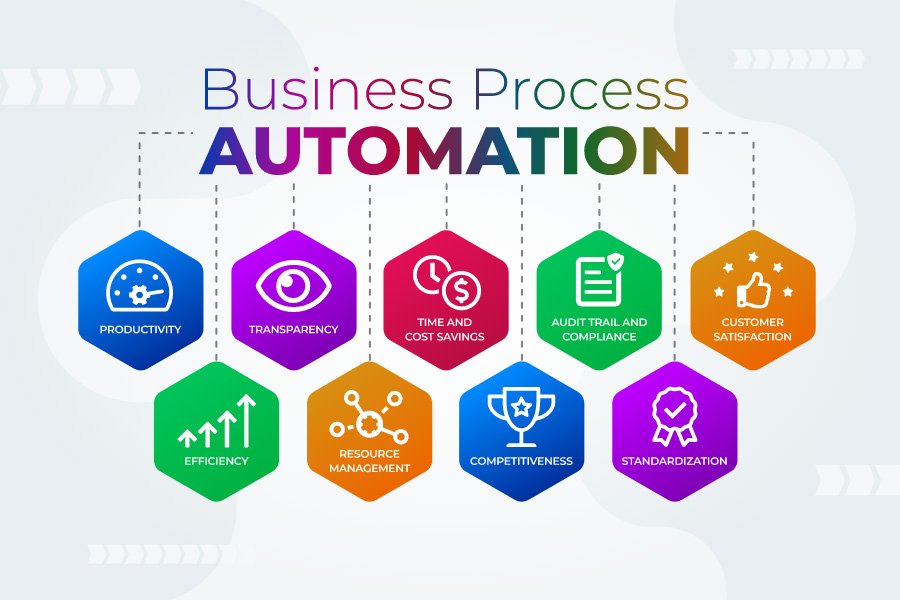Description
Business Process Automation
Business Process Automation (BPA)
What is Business Process Automation (BPA)?
Business Process Automation (BPA) refers to the use of technology to automate repetitive tasks, streamline workflows, and improve efficiency across an organization. It eliminates manual processes, reduces human errors, and enhances productivity by leveraging AI, machine learning, robotic process automation (RPA), and workflow automation tools.
Key Features of BPA Solutions
✔️ Workflow Automation – Automates routine tasks like approvals, notifications, and document processing
✔️ AI & Machine Learning Integration – Uses AI-driven insights for smart decision-making
✔️ Robotic Process Automation (RPA) – Automates repetitive data entry and back-office operations
✔️ Document Management – Digitizes, organizes, and secures business documents
✔️ CRM & ERP Integration – Seamlessly connects with enterprise systems
✔️ Task Scheduling & Notifications – Automates task assignments and alerts for employees
✔️ Reporting & Analytics – Provides real-time performance tracking and data-driven insights
✔️ Low-Code/No-Code Automation – Enables users to create automated workflows without programming skills
Types of Business Process Automation
1. Robotic Process Automation (RPA)
🔹 Focus: Automates repetitive, rule-based tasks using bots
🔹 Examples: UiPath, Automation Anywhere, Blue Prism
🔹 Use Case: Data entry, invoice processing, report generation
2. Workflow Automation
🔹 Focus: Automates multi-step business processes and approvals
🔹 Examples: Zapier, Nintex, Kissflow
🔹 Use Case: Employee onboarding, document approvals, task delegation
3. AI-Powered Process Automation
🔹 Focus: Uses machine learning and AI to make smart business decisions
🔹 Examples: IBM Watson, Microsoft AI, Google AI
🔹 Use Case: Chatbots, predictive analytics, customer sentiment analysis
4. Document & Content Management Automation
🔹 Focus: Automates document storage, retrieval, and security
🔹 Examples: DocuWare, M-Files, Laserfiche
🔹 Use Case: E-signatures, contract management, compliance documentation
5. Customer Service & Chatbot Automation
🔹 Focus: Enhances customer interactions through AI-driven chatbots
🔹 Examples: Drift, Intercom, HubSpot Chatbot
🔹 Use Case: Automated responses, lead qualification, support ticket handling
6. IT Process Automation
🔹 Focus: Automates IT operations like system monitoring, software updates, and security checks
🔹 Examples: ServiceNow, Ansible, Puppet
🔹 Use Case: Server maintenance, patch management, cybersecurity automation
BPA Development Process
1. Identify Processes for Automation
- Analyze repetitive and manual tasks
- Prioritize high-volume, error-prone, and time-consuming processes
2. Select the Right Automation Tools
🔹 RPA tools for back-office automation (UiPath, Blue Prism)
🔹 Workflow automation for task streamlining (Zapier, Power Automate)
🔹 AI-powered tools for predictive analytics (IBM Watson, Google AI)
3. Design & Implement Automation Workflows
- Define triggers, actions, and rules for automation
- Integrate with CRM, ERP, HRMS, accounting, and cloud services
4. Test & Optimize Automation
- Run pilot tests to ensure accuracy and reliability
- Monitor performance metrics, error rates, and ROI
5. Deploy & Scale Automation Solutions
- Roll out automated workflows across departments
- Continuously update systems based on new requirements
BPA Use Cases by Industry
📌 Finance & Banking
🔹 Automated loan processing for faster approvals
🔹 Fraud detection using AI-driven analytics
🔹 Automated compliance checks for regulatory adherence
📌 Healthcare
🔹 Automated patient scheduling and appointment reminders
🔹 AI-driven diagnosis & medical billing automation
🔹 Electronic Health Records (EHR) management
📌 Retail & E-Commerce
🔹 Inventory management automation to prevent stock shortages
🔹 AI-powered customer support chatbots
🔹 Automated order processing & returns management
📌 HR & Recruitment
🔹 Automated resume screening & candidate shortlisting
🔹 Employee onboarding workflows with digital document signing
🔹 Payroll automation & leave management
📌 Manufacturing & Logistics
🔹 Supply chain automation for real-time tracking
🔹 Predictive maintenance using IoT and AI
🔹 Automated quality control inspections
Challenges in BPA Implementation
⚠️ Employee Resistance – Fear of job displacement may slow adoption
⚠️ Integration Complexity – Ensuring compatibility with legacy systems
⚠️ Data Security Risks – Protecting sensitive business data from cyber threats
⚠️ Process Standardization – Automating inconsistent or poorly defined workflows









Reviews
There are no reviews yet.